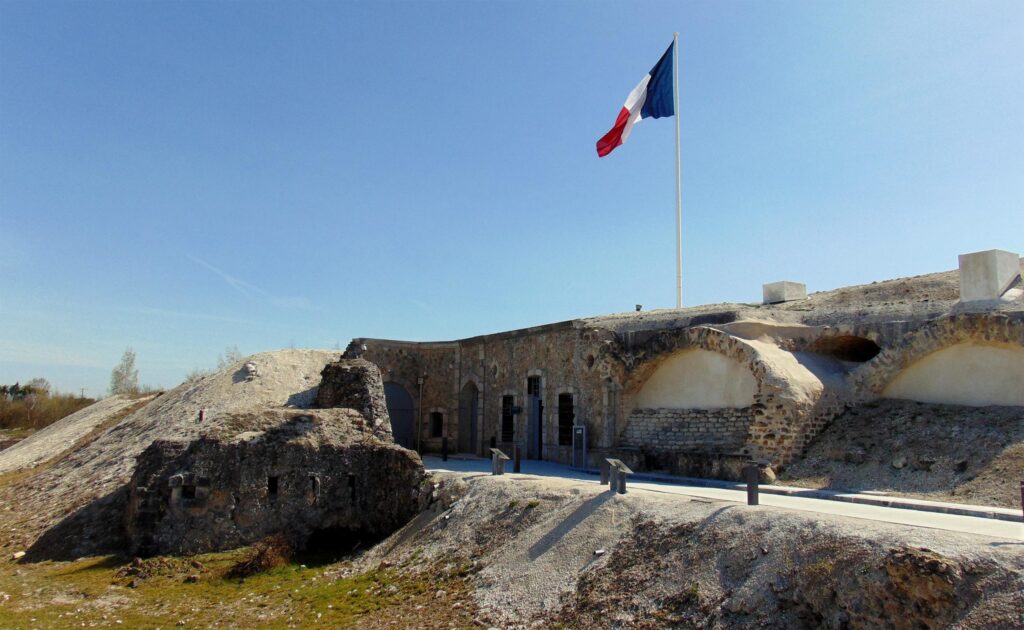Champagne Travel Guide & WW1 tours from Paris to Reims.
World War 1 Fort Pompelle museum. The rich WW1 collection is a municipal property. With the help of documents of that era, items of everyday life in the trenches, weapons, equipment, uniforms, mannequins of all participants in the battles and even artillery, the collection shows the events on the Western Front. The photo gallery includes modern and ancient views:
* Outdoor exhibition
* Uniforms and items of military equipment of the allied armies
* German army (Kaiser), uniforms and items of military equipment
* Russian Imperial Army. Special Brigades.
* Aviation. Exhibition dedicated to French pilots
* French, German and Russian artillery.
* Plan and history of the fortification. Underground communications.
* Views of the northern part of the Fort (from the German positions)
* Photos of the interior of the fort
* Opening hours, holidays and weekends, ticket prices
Fort de la Pompelle is a fortification of the First World War and is of interest to lovers of history, military affairs, engineering structures and ordinary tourists visiting the province of Champagne and the city of Reims on a sightseeing tour from Paris. Russian soldiers actively participated in the defense of the Pompelle fortress and the Russian section is one of the main ones in the museum exposition. In memory of the Russian soldiers of the expeditionary corps, memorial plaques were installed by various military organizations of the Russian emigration in France.
Fortress Pompelle, history briefly.
Founded in 1883. Height above sea level – 131 meters.
Original name: Fort Herbillon*
The garrison consisted of: 277 people, soldiers and officers.
Heavy weapons, artillery: 18 vehicles, including 5 155 mm guns and 4 138 mm guns.
Device: double and single caponier, powder cellar (depot of artillery shells) for 30 tons.
Current state: the main elements of engineering structures have been preserved, it is a military history museum of the city of Reims (Champagne).
*Emile Herbillon, general of the French army, a native of these places. Born in 1794 in Chalons-sur-Marne, died in Paris in 1866. Volunteer foot shooters of the Imperial Guard of Napoleon’s army. Veteran of military companies 1813-1814, including the Battle of Waterloo. Member of foreign trips to Spain and North Africa. During the Crimean War, he was a divisional general and participated in the battle for Traktir (August 16, 1855). He was the commandant of Genoa (1859) and a member of the Senate.
As described in detail in the section on the creation of a new concept of the Defense of France after the Franco-Prussian War and the creation of fortified positions, all the fortresses of the Reims region during the design were originally named after French generals. When construction began already on the ground, it turned out to be more practical to give them other names tied to their geographical location (thus the forts of Brimont, Vitry, Montbray, etc. appeared).
The case of “Fort Herbion” turned out to be more complicated, because it was approximately equidistant from three municipalities: Sillery, Taissy, Saint-Léonard, but due to a strange land registry, it was generally located on the territory of the municipality of Puilsieulx, whose main city was more distant. To avoid confusion and jealousy, it was decided to rename it, referring to the “Cross Pompelle”, which is located just a hundred meters from the fort. Since the late Middle Ages, the legend has been that Saints Timothy, Apollinaire and Maurus were executed and killed on the orders of the Roman prefect Lampadius near Fort Buxitus. However, Jacques de Voragine in the 13th century, in his Golden Legend, points to the death of martyrs in Italy. Be that as it may, but the popular rumor believed in the legend and every year on the day of the feast of Pentecost there was a large religious procession from the cathedral church of St. Timothy to Reims to the place of death of the alleged martyrs, carried out by Crucis Pompella, so named because the ceremony was done “without pomposity” (pompella in Latin). Thus, Fort Herbillon became known as Pompelle.
How to get fort from Paris and Reims
Local Taxi from Reims City to Fort – 50 Eu (one way, return ?)
Transfer from Disneyland or Charles de Gaule Airport – ?
Private WW1 tours from Paris to Champagne by a car
- Private Champagne tours from Paris by a car

